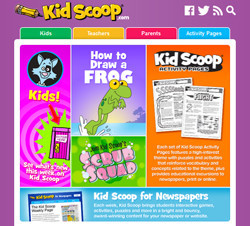NIE resurgence: Smaller newspapers are leading the comeback

In the good old days, Newspaper-in-Education programs had no downside.
Newspapers provided print copies to classrooms along with resources for teachers on how to integrate the newspaper into the curriculum. Advertisers defrayed the cost of the newspapers in return for being promoted and thanked as NIE sponsors. Newspapers had special NIE pages geared at kids. It was hoped that as students were exposed to their local papers, they would become engaged readers and eventually, lifelong subscribers.
But when print went into decline, NIE programs were the slow rabbits. To an individual publisher or a corporate decision-maker faced with rising print costs, falling circulation, reduced advertising and shrinking newsholes, NIE was a relatively easy budget cut.
 |
People were cutting pages, cutting participation in education or saying they were going out of business altogether. "We went through a big drop-off, really fast, like in a year," Whiting said. As the client list dropped to about 230, Whiting began to wonder if she might have to return to her old teaching career.
But business has begun turning around over the last six months, she said. Smaller, community newspapers, rather than the metro papers that used to have multiple staffers devoted to NIE, are leading the comeback. In response, Kid Scoop offers smaller programs, online options and is working on a couple of stand-alone publications.
"Where I'm really seeing a strong resurgence of NIE is at the community newspaper level," Whiting said. "It's so exciting because our kids and our families – we need to get the papers back in their hands. We need to show them how valuable it is."
The Wilson Times in eastern North Carolina is one community newspaper that would like to bring back an NIE program.
"We had a big-time NIE program, and when we did budget cuts, we cut that out," said Publisher Morgan Dickerman. "In the ideal world, it would be nice to start our NIE program back up on a small scale, so we're talking about that."
The Wilson Times publishes Monday through Saturday, with circulation near 12,000. Dickerman said he's excited about the possibilities, but a strong sponsor is mandatory. Both budget considerations and the results of a strategic marketing plan now being put together will determine if NIE can be revived.
"We're not going to do anything that we can't pay for," Dickerman said.
Whiting emphasizes that the original reasons for starting NIE programs – engaging children, and promoting literacy and civic education – are more important than ever.
"We know when students read newspapers once a week or more in the classroom, reading test scores go up an average of 10 percent," she said. "We know that people who read newspapers are more likely to vote and more likely to be involved in their communities. And all too many kids these days are growing up without newspapers in their homes. Where are they going to get the experience?"
A good NIE program also helps students learn to deal with the onslaught of information on the Internet, something that wasn't so important in the 1990s, she said. Now, students must learn to question the credibility and the sources of what they see online, to distinguish fact from opinion and truth from falsehood.
Whiting has found that larger papers are more likely to re-establish their NIE programs online, asking teachers to use their electronic editions rather than providing print copies for classrooms. While students need to learn to use the Internet and Whiting says NIE programs can incorporate both print and online, there are some drawbacks.
"Unfortunately, there's not a lot of good tracking going on," she said. "How many teachers are using the electronic edition?" Teachers may download the educational resources, but it's difficult to track actual usage, levels of teacher training, and, more practically, how many students are really reading a newspaper.
"What I'm finding is that at the elementary school level there is still a strong desire for print. The teachers want something the kids can write in, that they can cut and do physical things with," Whiting said.
Some teachers say they don't have time to search online for resources, and some don't even have enough ink cartridges to print things out. "When you bring them something that's already printed, that they can use immediately, they are so excited and so appreciative. And they use it."
Promoting education is a public service for newspapers, but they need not lose money doing it, Whiting said. NIE is similar to public radio and public television in that it requires strong sponsors who are willing to be partners with the paper and with the community. Marketing is essential; otherwise people won't know about NIE and sponsors won't gain visibility, she said.
"When it's done correctly – it's not advertising, the sponsorship model is very different – but there's money out there and it's new revenue for papers."
For more information, contact Vicki Whiting at vicki@kidscoop.com. Kid Scoop is represented by Contact That Works; contact Dan Dalton at dan@contentthatworks.com.
 |
|
Jane Nicholes |
Jane Nicholes, a regular contributor to the eBulletin, is a freelance writer and editor based in coastal Alabama. She is an award-winning veteran of more than 30 years in the newspaper business. Reach her at jbnicholes@att.net. Suggestions for future stories and comments on this piece are welcomed.






